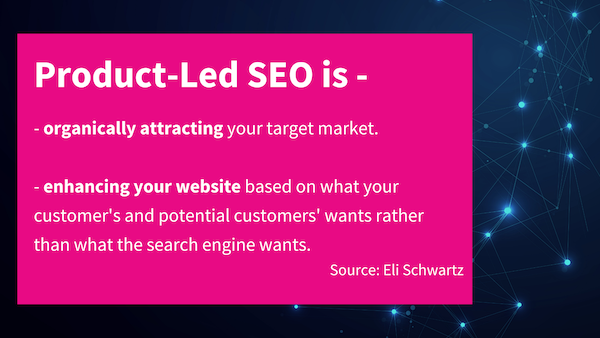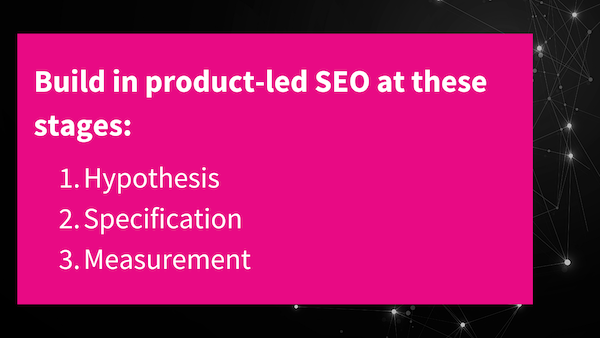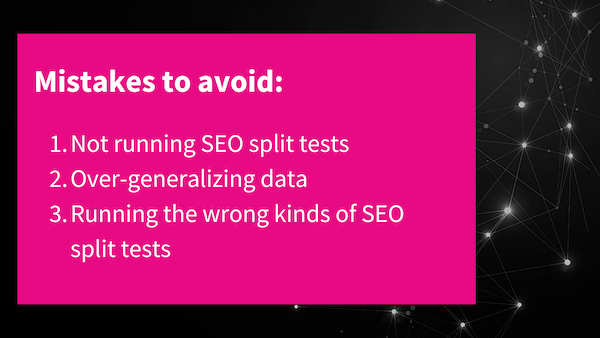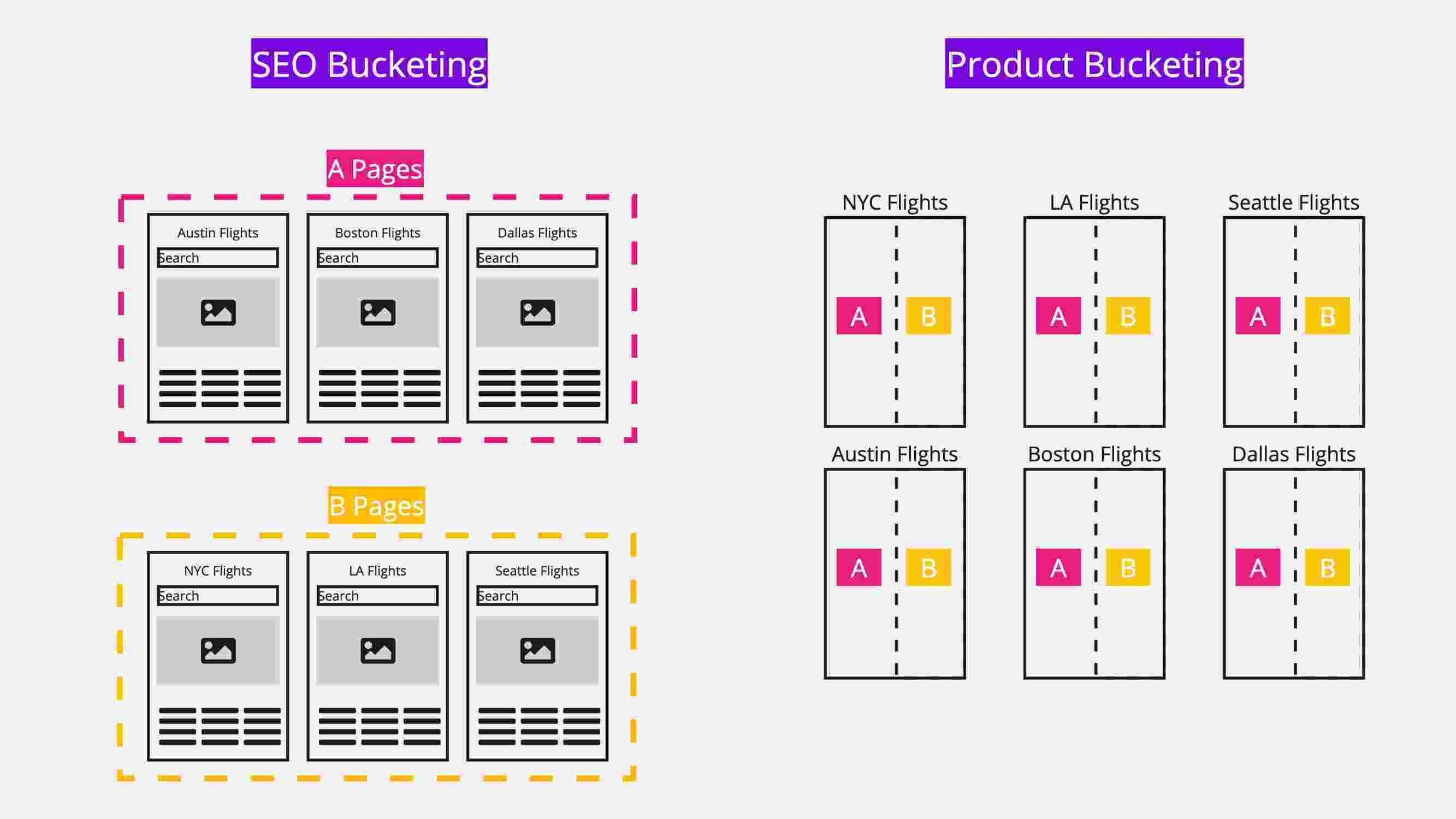Product-led SEO is the practice of researching your product improvements from a search engine perspective. The goal is to drive organic visibility by building content sections that are intimately related to your core product offering. Doing it well is an effective way to gain search term visibility that will drive your business performance.
You can look at search volume and Google trends to see what features customers are looking for, and use that data to inform what you build next. When you build landing pages and resources around new product features, you’ll organically rank for desired keywords that attract new customers to you. In many industries and verticals, this can be a path to building scalable site sections and landing pages.
In this post, we’ll share a helpful product-led SEO process and common pitfalls to avoid.
What is product-led SEO?
Product-led SEO (a term popularized by Eli Schwartz in his book of the same name) is seeking organic visibility improvements by enhancing your website. These website enhancements are driven by what customers want, rather than what search engines want. It’s an intentional approach to SEO.
It also brings search behavior research into your product development process by putting your customer and potential customer at the forefront of your decisions, so you’re building a product and additional features they truly desire. Put these together and you have a powerful tool for organically bringing more people in your target market to your site.

How to distinguish regular SEO from product-led SEO
Product-led SEO is at the intersection of SEO and product, but there are certainly areas of SEO that are not related to your product. Below we’ll cover some of the major differences to help clarify what product-led SEO is and isn’t.
SEO changes that are not related to your product
Some SEO updates, such as robot.txt changes or structured data mark-up, are independent of the product and therefore are not relevant within product-led SEO.
SEO can also include an editorial strategy where you build a content plan designed to target searchers. This strategy targets a market that is not actively researching solutions or products yet. Editorial SEO typically thinks in terms of pages and content.
SEO changes that are related to your product
Product-led SEO tends to build out pages and entire scalable site sections based on core product functionality and features. Zapier’s app integrations site section is a classic example of product-led SEO in action, while their blog is a more classical content-led editorial strategy.
Product-led SEO is truly the intersection of product and SEO. You need to think with an organic SEO hat on in the product improvement process and have explicit stages in the product development process that are focused on the SEO outcomes.

Here is what this looks like in practice.
How to build product-led SEO into your product strategy
There are a few key touchpoints where it makes sense to embed an SEO viewpoint into the product process:
Hypothesis
The first is at the very beginning when you’re exploring your product improvement ideas. There are numerous SEO opportunities at this stage where you can bring in search volume and Google Trends data to see what’s popular and growing. You can also bring in your existing analytics and search console data to see which pages and site sections are proving visible in organic search and effective at driving business.
With this data, you can not only improve the pure product-focused elements of the process with more data about demand, but you can also consider the benefits of building out entire scalable site sections with pages targeting large volumes of demand, and the growth opportunities that come with capturing that demand.
Specification
Then there are some critical checklist-type elements in the middle of the process where you are prioritizing all of those ideas. In this stage, you’ve got all these ideas in the hopper, and you’re working to understand how hard and impactful they are going to be.
To prioritize your ideas, your team can work on answering the following questions:
- Is there a potential SEO impact? What kind of landing pages or site sections (or page enhancements) could come from this change?
- How big is the SEO impact?
- How hard is it to capture more SEO impact with this particular change?
- Would this new feature have dedicated URLs for each appropriate piece of content?
- Would the content we produce be visible and indexable to search engines?
In an ideal world, you will use these insights to build the right things and take SEO considerations into account to make sure you build the best version of each thing you choose to build.
Measurement
The remaining piece of the puzzle is about closing the loop. In the same way that disciplined product teams evaluate their decisions to make sure they’re moving business metrics in the right direction (that their users are highly rating the site experience, converting better, spending more money, lasting longer as customers), you need to do the same thing from an SEO metrics perspective. For instance, are we improving organic search metrics as we roll out these changes? Are we growing revenue from organic search?
Following this process ensures that you have SEO embedded in your hypothesis, product specification process, and measurement.

3 things marketing leaders get wrong about product-led SEO
While product-led SEO is a process that is continuously evolving, there are some mistakes that we see marketing leaders make that can be avoided.
1. Not running SEO split tests
The biggest mistake we see is not testing at all. True product-led SEO requires a feedback look where you find out: “Did our users like this change?”
2. Overgeneralizing from “before and after” data
There are a lot of smart SEO teams that get bogged down in complexity and data.
Many teams aren’t familiar with scientific SEO split tests. In those cases, they’re often looking at before and after data. For example: “This is how it was performing before we rolled out the change and here’s how it’s performing now.” This often doesn’t work well because results are easily confounded by seasonality, Google algorithm updates, or your competitor’s actions. It makes the data noisy. In this case, the team is often chasing a statistical ghost.
In order to avoid over-generalizing from the data you have, you’ll need to do a scientific SEO split test and use advanced statistical tools.
3. Running the wrong kinds of SEO split tests
Another area where smart SEO teams trip up is either running the wrong split tests or not running nearly enough.
This is likely a product development problem, but it definitely manifests itself in product-led SEO where either the hypotheses aren’t bold enough, they’re not going to move the needle even if they do work, or simply the cadence is too slow.
In our experience, the sites that are performing the best are also iterating fast. They are releasing new ideas to the market, seeing how the market responds, and using product-led SEO to see how Google responds. And they’re doing that at a much faster pace than their competitors.
Conclusion
Product-led SEO is about establishing the right process where SEO implications are factored in at the hypothesis, specification, and measurement stages of product development.
At SearchPilot, we’re passionate about educating people about product-led SEO so they can achieve incredible business results. And access to our scientific split tests empowers teams to measure the results of this strategy, allowing them to move forward in a strategic and powerful way.
If you are ready to take a more scientific approach to SEO split-testing, request a free demo of SearchPilot.



